George Legendre, Emanuele Mattutini, Jean-Aime Shu,
and Alfonso Senatore
Designed for Site #3 in Abu Dhabi, on Airport Road near Masdar City.
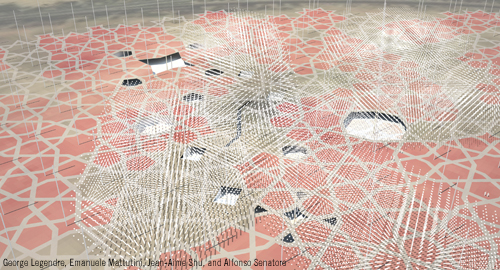
Design Submission for the 2010 Land Art Generator Initiative Design Competition
Artist’s descriptive text:
Introduction
PV (for Photovoltaic) Dust is a site-specific Land Art installation producing clean energy with astonishing efficiency. It is strategically located on the outskirts of Masdar City, the first zero-carbon-footprint agglomeration in the world, next to Abu Dhabi Airport, UAE.
PV Dust covers 175,000m2 of desert ground with a new breed of photovoltaic technology, aggregating into a cloud of energy-producing dust. The PV Dust cloud has an eerie presence, recalling the great desert sand storms of the Gulf.
Below the cloud, a network of sand-coloured gravel paths striates the territory. Seen from the flight path of incoming, airport-bound jets, the forking pathways assume the appearance of traditional Islamic lattices. Made of sand-colored gravel, Pebbles and crushed roof tiles, this landscape relies on a distinct desert palette and does not need to be watered.
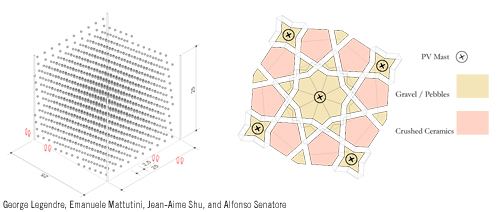
At the heart of PV Dust lies a new lower-ground complex of leisure and retail amenities, conveniently located on the Masdar City Light Railway Transit system. The complex facilitates access to an otherwise isolated location and helps maximize the commercial potential of the site.
Future Visions
PV Dust, the photovoltaic farm of the future, is made of 279 cubic modules of 25m*25m*25m featuring innovative, omni-directional PV technology.
Our proposal for a new type of PV farm works with, and extends, the green transportation guidelines issued by and for the neighboring Masdar City. At the time of writing we assume that the LRT will be located underground. If not, the position of the PV module grid takes into account the hypothetical route of the LRT and could be adapted to work with an over-ground light transportation system (simply by removing those modules standing in the way).

Hence PV Dust is a scenario as much as a proposal. Depending on the amount of energy required, the modular PV Dust cloud could be resized to meet those needs, and then grow incrementally over an unspecified period of time, like an orchard or vine.
A Compact and Powerful Idea
At peak power, the Sphelar® Cells used by PV Dust produce around 40 MW (please refer to next section). To generate a similar amount of electricity, an alternative solution using traditional flat PVs would require 310,159m2 of polycrystalline photovoltaic panels.
Our installation fits on just 174,375m2 of land. This is about 57% of the catchment of flat PVs. Our proposal has a substantially smaller footprint, it does not block access to the ground, and it spares valuable earthbound resources.
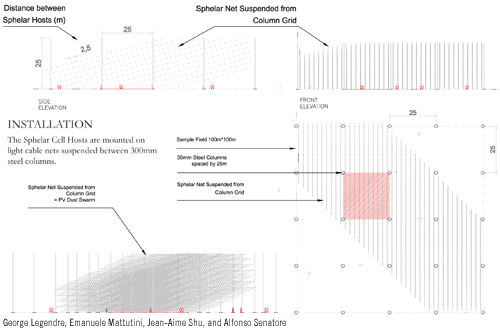
How Sphelar® Works
Flat solar cells are unable to effectively harness indirect light. Moreover, in order to obtain a stable supply of power, their orientation needs to face the sun. By contrast, the new Sphelar® Cell technology developed by Kyosemi Corporation, Japan, captures light from all directions at once, including reflected and diffused light. Its spherical light-receiving surface does not need to track the sun, and hence, Sphelar® achieves unprecedented levels of energy efficiency.
With a diameter of a mere 1 to 1.5mm, Sphelar® Cells can be connected in parallel or in series. This enables diverse spherical products to be created, such as dome-shaped solar cells and “flexible” solar cells aligned on soft film substrates. Our proposal assumes Sphelar® Cells are grafted on a light plastic sphere of 500mm diameter, called a Host. Collectively, the Hosts make PV Dust.
Art Installation / Proper Power Plant
PV Dust functions as a proper power plant. Solar irradiation is collected by the Sphelar Cells, which generate DC electricity. DC electricity is converted into AC electricity by Inverters. Each 25m*25m bay has its own Inverter, located at its base in a small buried plant. Once DC is converted into AC, 20 11kV Transformers transform the voltage and pass it to 4 Main Network Transformers that feed it to a switch board. These devices are located in an underground plant on the edge of the site, cooled via a passive ventilation system (labyrinth cooling). Subsequently the power reaches end users via the power grid. PV Dust supports 3 densities of energy-producing cloud, with commensurate levels of performance.
(a) Small Plant
Distance Between SPHELAR® Hosts: 3.125 meters
Total Number of Hosts: 175,770
Total Number of SPHELAR® Cells: 12.4m
Total Annual Energy Produced: 25,472,675 kWh/yr
Total Number of UAE 3-Bedroom Houses Powered: 5,095(b) Medium Plant
Distance Between SPHELAR® Hosts: 2.5 meters
Total Number of Hosts: 297,693
Total Number of SPHELAR® Cells: 21m
Total Annual Energy Produced: 41,723,767 kWh/yr
Total Number of UAE 3-Bedroom Houses Powered: 8,345(b) Large Plant
Distance Between SPHELAR® Hosts: 1.92 meters
Total Number of Hosts: 460,350
Total Number of SPHELAR® Cells: 32.5m
Total Annual Energy Produced: 63,821,598 kWh/yr
Total Number of UAE 3-Bedroom Houses Powered: 12,767
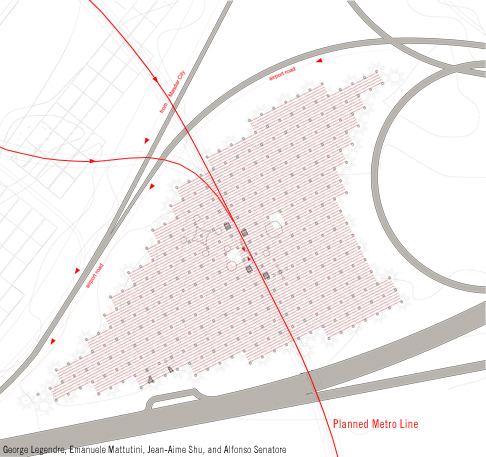
Public Visitors’ Centre
PV Dust will become a local landmark for residents and tourists. With no car parking provided, only public transport, visitors will board Masdar City LRT and alight at the heart of a lower ground complex of galleries, restaurants, and shops.
All retail and leisure amenities are laid out around deep patios that maximise the influx of daylight, while providing cool and shaded peripheral galleries.
Visitors will perceive the cloud of PV Dust from every corner of this lower ground complex. Should they wish to visit the installation itself, they can use the public stairs on either side of the LRT platforms to reach the ground floor and walk though the gravel pathways for a quick tour of PV Dust.
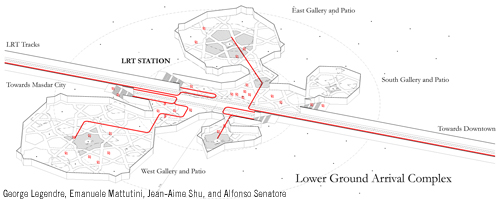
Related Posts
1 Comment
Add comment Cancel reply
This site uses Akismet to reduce spam. Learn how your comment data is processed.

[…] to reach the ground floor and walk though the gravel pathways for a quick tour of PV Dust. Source: Land Art Generator Initiative Reageer […]